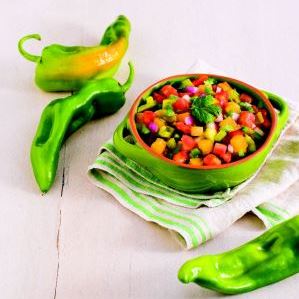Chile Peppers are Widely Available Year-Round
This vibrant Heirloom Tomato Chile Salsa spices up summer barbecues and complements any Mexican dish. Click here for the recipe.
BUY IT: Commonly mistaken as a specific variety of pepper, Hatch simply refers to the region where these flavorful chiles are grown. “The most popular varieties include Lumbre, Big Jim, Sandia, New Mexico 6 and Lumbre,” says Tina Cabrales, coordinator of the annual Hatch Chile Festival in late August. Their sought-after, generally mild flavor is attributed to Hatch Valley’s rich soil, Cabrales says, but there are a lot of knockoffs, especially at farmers’ markets and roadside stands. Anaheim, poblano and Colorado peppers are great substitutes when Hatch chiles aren’t available. Pick peppers with smooth, firm, somewhat shiny skin that’s free of blemishes.
STORE IT: Most fresh chile varieties will keep for two weeks in a cool, dry place, such as a paper bag in a refrigerator. If you won’t use them within that time, hang or set the chiles out to dry, and then seal them in an airtight container. When you’re ready to use them, soak them in water for about an hour to bring them back to their original form. You can also grind dried peppers into powder for use in recipes.
PREP IT: Roasting is the preferred prep method for Hatch chiles because it brings out their mild, smoky flavor. Arrange them on a foil-lined baking sheet, and place under a broiler for 10 to 15 minutes, until the skin chars. Remove and place in a large zip-top bag while chiles are still warm. Allow to sit in the sealed bag for about 20 minutes, and the charred skin will naturally loosen. When the peppers are cool, remove from the bag one by one and peel off the charred skin. You can freeze the roasted peppers at this point (in a well-sealed container) or gently slice open the peppers and remove the seeds before chopping, slicing or stuffing them.
If fresh Hatch or Anaheim chiles aren’t available, you can substitute canned whole, sliced or diced green chiles.

